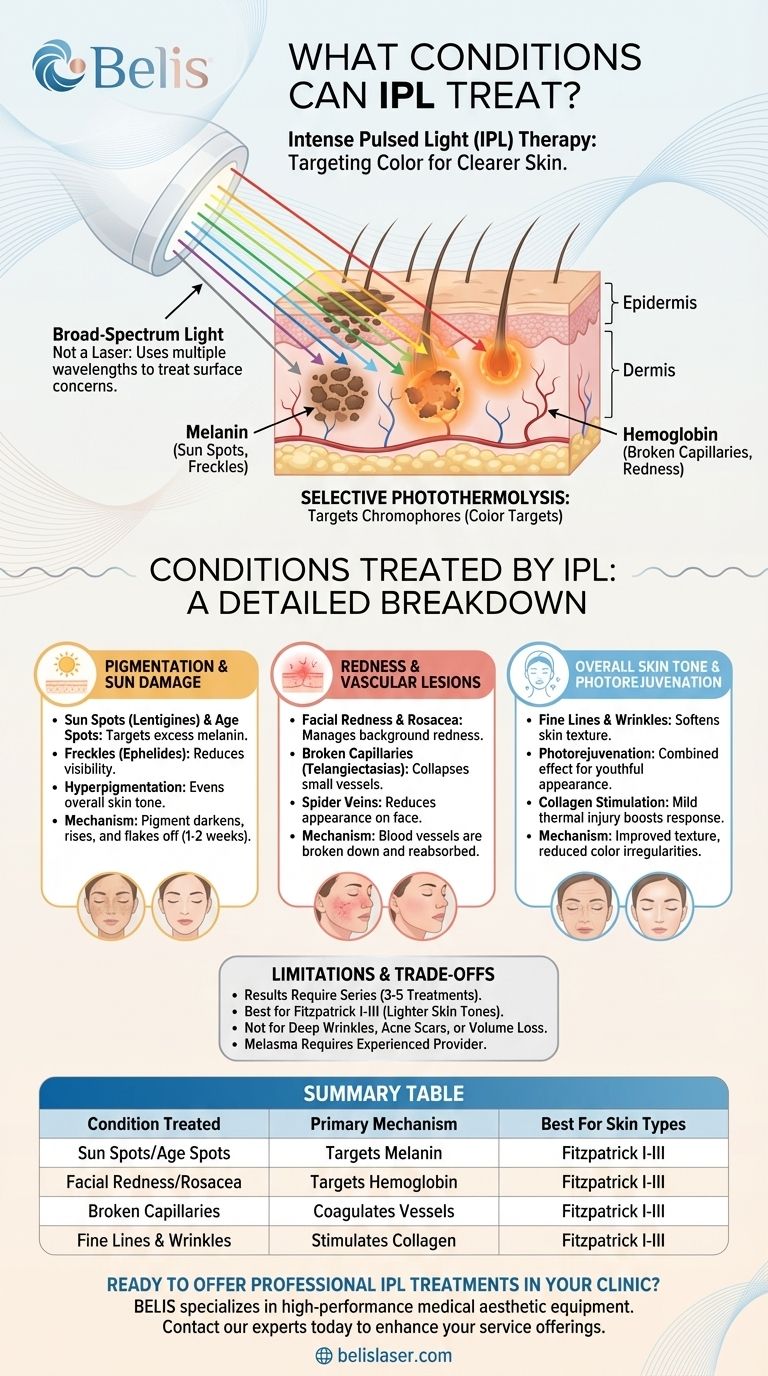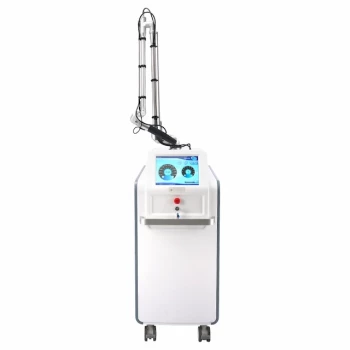In short, Intense Pulsed Light (IPL) therapy is FDA-approved to treat a range of skin conditions, primarily those related to unwanted pigmentation, sun damage, and vascular irregularities like facial redness. It is a light-based treatment, often called a "photofacial," that addresses concerns like brown spots, broken capillaries, and overall skin tone by targeting specific colors within the skin.
IPL is not a laser but a broad-spectrum light that selectively targets and heats pigment (melanin) and redness (hemoglobin). This process damages the unwanted cells, which are then cleared by the body, making it an excellent solution for surface-level color correction but less effective for deep textural issues.

How IPL Works: Targeting Color with Light
To understand what IPL can treat, you must first understand its mechanism. The technology is based on a principle called selective photothermolysis.
The Role of Chromophores (Color Targets)
IPL devices emit a broad spectrum of light, unlike lasers which use a single, focused wavelength. This light is delivered in rapid, powerful pulses.
Different structures in the skin, known as chromophores, absorb different wavelengths of light. The primary targets for IPL are melanin (the brown pigment in sun spots and hair) and hemoglobin (the red pigment in blood vessels).
Using Heat for Selective Destruction
When the melanin or hemoglobin absorbs the light energy, that energy is converted into heat. This heat precisely damages the target—be it an unwanted pigment cell or a tiny broken capillary—without harming the surrounding, lighter-colored skin tissue.
The Body's Natural Healing Process
Following the treatment, the body’s natural processes take over. The damaged pigment cells darken, rise to the surface, and flake off over the course of a week or two. Damaged blood vessels are broken down and reabsorbed by the body. This entire process results in a clearer, more even, and more radiant complexion.
Conditions Treated by IPL: A Detailed Breakdown
IPL is highly versatile due to its broad spectrum of light. The FDA has approved its use for several common cosmetic concerns.
Correcting Pigmentation and Sun Damage
This is IPL's most common application. It effectively targets excess melanin that appears as discoloration on the skin's surface.
- Hyperpigmentation: A general term for any darkening of the skin.
- Lentigines: Commonly known as sun spots or age spots. IPL is a gold-standard treatment for these.
- Ephelides: The medical term for common freckles.
Reducing Redness and Vascular Lesions
By targeting hemoglobin, IPL can collapse and eliminate small, visible blood vessels that cause persistent redness.
- Telangiectasias: These are the fine broken capillaries or "spider veins" that often appear around the nose and on the cheeks.
- Rosacea: IPL is highly effective at reducing the background redness and flushing associated with rosacea. It is not a cure, but it significantly manages symptoms.
Improving Overall Skin Tone (Photorejuvenation)
This is a broader term that encompasses the total effect of an IPL treatment. The heat generated during the session also creates a mild thermal injury in the dermis, which stimulates a low-level collagen response.
- Facial Wrinkles: IPL is best for very fine lines rather than deep-set wrinkles. The modest collagen production helps soften skin texture over time.
- Photorejuvenation: The combined effect of reduced pigment, diminished redness, and subtle textural improvement gives the skin a healthier, more youthful appearance.
Managing Melasma
While the FDA has approved IPL for melasma—patches of dark discoloration often triggered by hormones—this is a complex application. The heat from IPL can sometimes worsen melasma in certain individuals, so it must be performed by a highly experienced provider.
Understanding the Trade-offs and Limitations
While effective, IPL is not a universal solution for every skin concern. Understanding its limitations is crucial for managing expectations.
It Is Not a Laser
A laser uses a single, coherent wavelength of light to hit a very specific target. IPL uses multiple wavelengths. This makes IPL more of a "shotgun" approach compared to a laser's "sniper rifle." For certain deep or specific targets, a laser may be a better choice.
Skin Tone Is a Critical Safety Factor
Because IPL targets melanin, it works best on individuals with lighter skin tones (Fitzpatrick types I-III). In darker skin, the light cannot easily distinguish between the excess pigment in a sun spot and the natural pigment in the skin. This significantly increases the risk of burns, blisters, or unwanted pigmentation changes.
It Is Not for Deep Texture Issues
IPL works on the surface. It is not the correct treatment for deep acne scars, significant volume loss, or deep-set wrinkles. These conditions require different modalities like ablative lasers, dermal fillers, or microneedling.
Results Require a Series of Treatments
A single IPL session will yield visible results, but a series of 3 to 5 treatments, spaced about a month apart, is almost always necessary for an optimal outcome. Maintenance sessions may be needed annually to preserve the results.
Making the Right Choice for Your Goal
To decide if IPL is right for you, match the technology's strengths to your primary skin concern.
- If your primary focus is widespread sun damage, freckles, or age spots: IPL is often considered a first-line treatment for clearing surface-level pigmentation across the face, chest, or hands.
- If your primary focus is facial redness, rosacea, or broken capillaries: IPL is highly effective at targeting the underlying vascular issues and reducing the overall "ruddy" complexion.
- If your primary focus is deep wrinkles or significant acne scarring: You should explore other modalities like fractional lasers or microneedling, as IPL only addresses fine lines and surface irregularities.
- If you have a darker skin tone or are treating melasma: You must consult a board-certified dermatologist who specializes in treating skin of color to discuss the significant risks and potential alternatives.
Ultimately, understanding that IPL excels at correcting color irregularities on the skin's surface is the key to determining if it aligns with your aesthetic goals.
Summary Table:
| Condition Treated | Primary Mechanism | Best For Skin Types |
|---|---|---|
| Sun Spots / Age Spots | Targets melanin pigment | Fitzpatrick I-III |
| Facial Redness / Rosacea | Targets hemoglobin in blood vessels | Fitzpatrick I-III |
| Broken Capillaries | Coagulates and eliminates vessels | Fitzpatrick I-III |
| Fine Lines & Wrinkles | Stimulates collagen production | Fitzpatrick I-III |
| Overall Skin Tone (Photorejuvenation) | Combined effect of reduced pigment & redness | Fitzpatrick I-III |
Ready to offer professional IPL treatments in your clinic?
BELIS specializes in high-performance medical aesthetic equipment, providing reliable IPL systems that help medical aesthetics clinics and premium beauty salons deliver safe, effective photorejuvenation results. Our technology is designed for precise color correction and consistent outcomes.
Contact our experts today to learn how our IPL solutions can enhance your service offerings and grow your business.
Visual Guide

Related Products
- IPL SHR+Radio frecuency machine
- 4D 12D HIFU Machine Device for Skin Tightening and Lifting
- 12D HIFU Machine Device for Facial HIFU Treatment
- 7D 12D 4D HIFU Machine Device
- Hydrofacial Machine with Facial Skin Analyzer and Skin Tester
People Also Ask
- How often should I use an RF machine on my face? Optimize Your Treatment Schedule for Best Results
- Does IPL hair removal have other benefits? Discover the Skin Rejuvenation Perks
- What is the difference between SHR and laser hair removal? Choose the Right Method for You
- Are radio frequency skin treatments safe? A Guide to Professional RF Safety & Results
- How does an RF machine work? Unlock the Science of Non-Surgical Skin Tightening



















